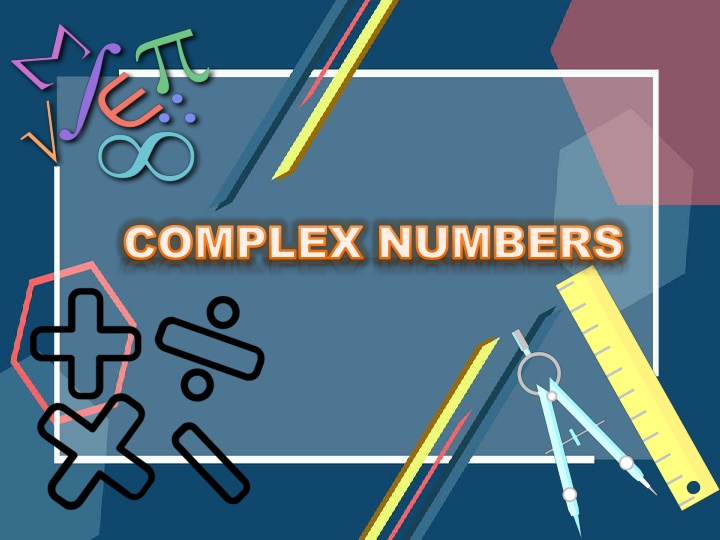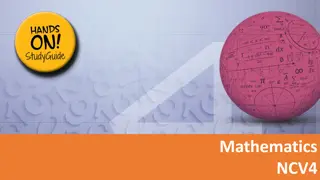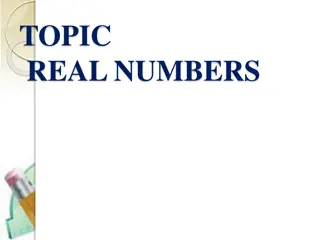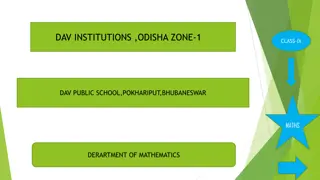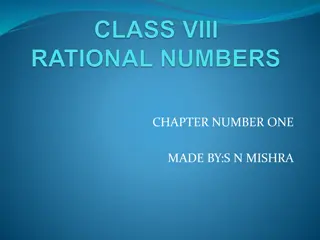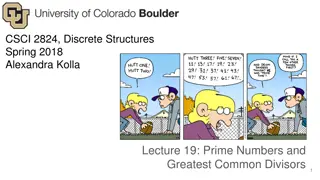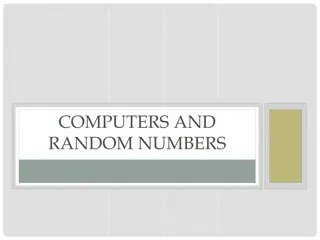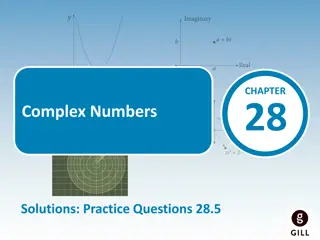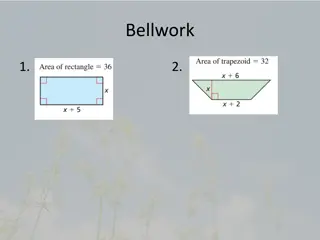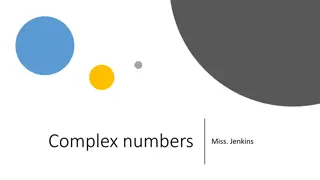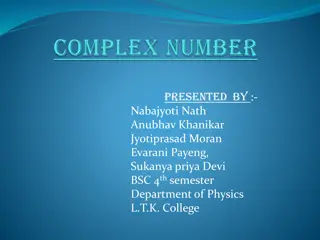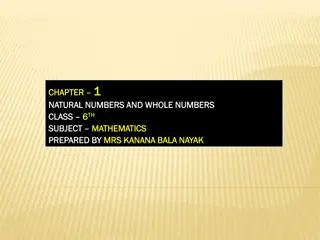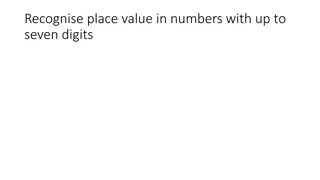Comprehensive Guide to Complex Numbers - Learning Objectives, Key Concepts, and Previous Knowledge Testing
This comprehensive guide provides detailed information on complex numbers, including learning objectives such as identifying complex numbers, applying algebra, understanding properties like conjugates and moduli, finding square roots, and representing in polar form. Key concepts covered include integral powers of iota, introduction to complex numbers, algebraic operations, geometric representation, and more. The content also includes a previous knowledge testing strategy and explanations by the teacher on the concept of imaginary numbers like i and their properties. It’s a valuable resource for students studying complex numbers.
Download Presentation

Please find below an Image/Link to download the presentation.
The content on the website is provided AS IS for your information and personal use only. It may not be sold, licensed, or shared on other websites without obtaining consent from the author.If you encounter any issues during the download, it is possible that the publisher has removed the file from their server.
You are allowed to download the files provided on this website for personal or commercial use, subject to the condition that they are used lawfully. All files are the property of their respective owners.
The content on the website is provided AS IS for your information and personal use only. It may not be sold, licensed, or shared on other websites without obtaining consent from the author.
E N D
Presentation Transcript
COMPLEX NUMBERS COMPLEX NUMBERS
LEARNING OBJECTIVES Students will be able to identify the complex number . They will be able to apply the algebra of complex number They will remember the properties of conjugate and modulus of complex numbers They will be able to find out the square roots of complex numbers and solve the quadratic equations They will represent the complex numbers in polar form.
KEY CONCEPTS Integral powers of iota. Introduction of complex number. Algebra of complex number. Conjugate and its properties. Modulus and its properties. Geometrical Representation of a complex number. Argument or Amplitude of a complex number. Square root of a complex number.
PREVIOUS KNOWLEDGE TESTING STRATEGY The following questions will be asked to test the previous knowledge of the students : 1. , - 2. Find a natural no. satisfying 2x + 3 = 8 3. Find a rational no. satisfying 2x + 3 = 8 4. Find x in R , if - 4 = 0 5. Find x in R , if + 4 = 0 x 4 4 2 x 2
2 2 = 4 ( 2) ( 2) = 4 0 0 = 0 EXPLANATION BY TEACHER If we multiply a number with itself result is always positive, or zero. It seems like we cannot multiply a number by itself to get a negative answer but imagine that there is such a number (call it i for imaginary) that could do this: i x i = -1 i Well, by taking the square root of both sides we get this : = -1 Which means that i is the answer to the square root of 1.
N.B : Euler was the first to introduce the symbol i Which is actually very useful because by simply accepting that iexists we can solve things that need the square root of a negative number. = ) 1 = = 4 4 ( )( 4 1 i 2 N.B : x = i , x is a positive real no. x Leonhard Euler 1707-1783
iis the symbol with the property that is called imaginary unit. It is not a real number. = 2 1 i We can also show this by the method of contradiction. then we know that i > 0, i = 0or i < 0 , R i If (product of two positives.) 0 * = i i 2 , 0 i i If we take That is, -1 > 0 which is false. Therefore, i cannot greater then 0. Similar contradiction can be arrived at by supposing that if , i = 0 and i < 0. Thus, we can conclude that i is neitherpositive nor zero nor negative. By the Trichotomy property, it follows that is inot a real number.
INTEGRAL POWER OF i 1 1 = = = = = = = = = 2 3 2 4 2 2 , 1 . . 1 , . . 1 1 , 1 i i i i i i i i i i i i For any integer , + + + = = = = 4 4 1 4 2 4 3 k k k k , 1 , 1 & i i i i i i where, k is an integer.
DEFINITION OF A COMPLEX NUMBER If a and b are real numbers, the number a + ib is a complex number, and it is said to be written in standard form. Let a complex number z = a + ib. Here, a = Real part of z = Re(z) b = Imaginary part of z = Img(z) If b = 0, the number a + ib = a is a real number If a = 0, the number a + ibis called an imaginary number.
COMPLEX NUMBER Real numbers and Imaginary numbers are subsets of the sets of complex numbers. REAL NUMBERS IMAGINARY NUMBERS COMPLEX NUMBERS
Example: Write the complex number in standard form + = + 8 1 1 8 1 = + a + ib = ) 2 1 2 ( i 2 2 where a= 1 and b=
EQUALITY OF TWO COMPLEX NUMBER Let z1= a + ib and z2 = c + idare two complex numbers. Then, z1 = z2, iff, Re(z1) = Re( z2) and Img(z1) = Img(z2) That is iff, a = c and b = d
ADDITION AND SUBSTRACTION OF COMPLEX NUMBER If a + ib and c + idare two complex numbers written in standard form, their sum and difference are defined as follows : Sum = (a + ib) + (c + id) = (a+c) + i(b+d) Difference = (a + ib) - (c + id) = (a-c) + i(b-d) Ex: (3 + 2i) (6 + 13i) = 3 + 2i 6 13i = 3 11i
MULTIPLICATION OF COMPLEX NUMBER (a + ib) (c+ id) = (ac- bd) + i(ad+ bc) Note: Multiplying complex numbers is similar to multiplying polynomials and combining like terms. (6 2i)(2 3i) = 6 (2 3i) - 2i ( 2 3i ) = 12 18i 4i + 6i2 =12 22i + 6(-1) = 6 22i Ex:
DIVISION OF COMPLEX NUMBER + + ( ) ( ) ( ) a bi a bi c di = + + ( ) ( ) ( ) c di c di c di + 2 ac adi bci + bdi = 2 2 c d + + ( ) ac bd bc ad i = + 2 2 c d
EXAMPLE + ( 6 7 ) ( 6 7 ) 1 ( 2 ) i i i = + 1 ( 2 ) 1 ( 2 ) 1 ( 2 ) i i i + 2 2 6 12 7 14 i i i = + 2 1 2 + + 4 6 14 5 i = + 1 + 5 20 5 i = 20 5 i = + 5 5 = + 4 i
Let z = x + iy; x,y R, Conjugate of z is : = + = ( ) z x iy x iy Properties of Conjugate z z = Im( 2 ) 2 + = ) 1 2 Re( ) z ) z z z 2 = = + 2 2 ) 3 . [Re( )] [Im( )] z z z z z + + + + = + + + + ) 4 .......... .... .......... z z z z z z z z 1 2 3 1 2 3 n n z z = ) 5 1 1 z z 2 2 ( ) ( ) z z + n = n ) 6 , z z n N = ) 7 , iff z is purely imaginary ( ) z z = , iff z is purely real = 0 ) 8 z z ) 9
MULTIPLICATIVE INVERSE OF A COMPLEX NUMBER : If z 0 , then multiplicative inverse of z is : 1 z= z 2 z
MODULUS OF A COMPLEX NUMBER Let z = x + iy; x,y R, Modulus of z is : = + = + 2 2 2 2 (Re( )) (Im( )) z x y z z Properties of Modulus . ) 1 z z = 2 = = + 2 2 z x y = 2 ) z z = z = 3 ) 0 0 If z z = 4 ) z z z z 1 2 = 1 2 n n 5 ) z z z z 1 = 6 ) 1 z z 2 2 + + 7 ) z z z z 1 2 1 2
AMPLITUDE / ARGUMENT OF A COMPLEX NUMBER AND ITS POLAR FORM :- Argand plane or Complex plane : The plane having a complex number assigned to each of its point is called complex plane or Argand plane . The x-axis and y-axis in the Argand plane are called real axisand imaginary axis respectively. Let z = x + iy is a complex number. The co-ordinates of P(x,y) and x z OP + = = 2 2 y
Let z = x +iy, then P(x,y) = P( ) where, P( ) is the polar co-ordinate of the point) , r , r Let, x = r cos , y = r sin So, z= r(cos + i sin ) is the polar form of z. y is the arg(z) or amp(z), where tan = x Principal argument of z is , where
Position Of z Principal arg(z) = Positive x-axis 0 Positive y-axis 2 Negative x-axis Negative y-axis 2 1st Quadrant y = = isacute , tan , where where x 2nd Quadrant = 3rd Quadrant = ( ) 4th Quadrant =
SQURE ROOT OF COMPLEX NUMBER Let z = x +iy, the square root of is z = + = + Let, z x iy a ib + + = + 2 2 2 x iy a b i ab Therefore, x = a2 - b2 and y = 2ab On solving a and b we can find square root of z.
Complex numbers has a wide range of application in Science, Engineering, Statistics, etc. Applied mathematics : Solving different equations with function of complex roots. Cauchy s Integral Formula Calculus of residues In Electric Circuits : To solve electric circuits
HOW COMPLEX NUMBERS CAN BE APPLIED TO THE REAL WORLD Examples of the application of complex numbers: Electric Field and Magnetic Field. Application in Ohm s Law. In the root locus method, it is especially important whether the poles and zeros are in the left or right half planes. A complex number could be used to represent the position of an object in a two dimensional plane.
CONCEPT MAPPING Standard Form z = a+ib Sum of z1+z2=(a+c)+i(b+d) Any+ ve Set of Real No. Product of z1z2=(ac-bd)+i(ad+bc) Complex No. a+ib Multiplicative Inverse a + + b i a = Real Part b = Imaginary Part + 2 2 2 2 a b a b Conjugate = Any ve Set of Imaginary No. z a ib A polynomial equation with degree n, has n roots. ax2 +bx+c=0 ; a 0, b-4ac<0 x= Polar Form z = a+ib=r(cos +i sin ) where, r = , modulus of z cos = sin = r a + 2 2 b a b b Di r 4 a
